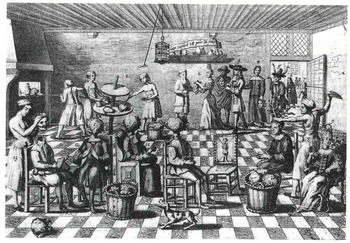JF Ptak Science Books LLC Post #111
Here’s a very curious engraving, a little on the light-noirish side, by the Dutch Philibert Bouttats de Jongere (1656-1728). The copperplate is made from a painting called De Bakker von Eeklo (The Baker of Eeklo) which hangs in the Muiderslot castle in the town of Muiden, near Amsterdam—I found the reproduction in a very charming book by Midas Dekkers called The Way of All Flesh, a Romance of Ruins (2000). Dekkers thinks about reflects (and I use this word in the clinical, autopsy-room way) on the way of all fleshly ruination—what happens to cause it, what the mechanisms of deformation are, and the effects of time on us all. He comes to this engraving in a chapter of fighting the effects of the physical and biological mechanics of skin and plastic surgery. It is a marvelous image—people coming to the bakers for a rejuvenation and reformation of their entire head. How it seems to happen is this: people arrive from far and wide and have their heads removed by a baker’s assistant (as at left), where a group of bakers work their wonders (with paints and other stuff) on a revolving table, when the head is sent to what looks like a bread oven for a firing and cooking. In the meantime the cabbages that are kept in baskets an laying about on the floor are actually put to use—they are placed in the bottom/wound of the removed heads and also serve as replacement headholders until the baked heads are ready. (Cabbage head?) For some reason all of the bakers are without shirts; it is after all a bakery and it probably is hot, but everyone else is dressed pretty heavily, and looking pretty calm, so maybe there’s something more to the shirtless bit than just heat. And speaking of calm, most of the head-rejuvinatees are sitting very patiently, with their hands together, or fingertips touching, in classic aspects of ease, and I’m not sure about that, either.
But is that really the story here? The odd part of this odd allegory is that the people in the upper right, entering the bakery, are already carrying heads. It makes sense in an artful way to have a cabbage replace your own cooking head, but if you were coming to the baker with head-in-hand and set to go, then you wouldn’t need a cabbage head for your own decapitated noggin because, well, they’d lop of your own head and replace it with the new one right away; no cabbages necessary. So perhaps there are two different things going on here: one where you get your own head re-worked, and a second where you bring in a head to have put on your own body.
The big question in the room then is where did these other heads come from?



Comments